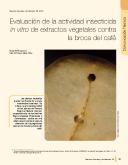Evaluación de la actividad insecticida in vitro de extractos vegetales contra la broca del café

Ver/
ISSN
e-ISSN: 1659-1216Fecha de publicación
12-2009Tipo
Artículo
Metadatos
Mostrar el registro completo del ítemTítulo alternativo
Evaluation in vitro of vegetal extracts insecticidal activity against the coffee berry borer
Descripción
6 páginas, 2 ilustraciones, 1 tabulación, 25 referencias.
Resumen
En la búsqueda de plantas con actividad insecticida para ser empleadas en el manejo integrado
de la broca del café (Hyphothenemus hampei),
se evaluaron 46 extractos crudos de diclorome tano y metanol obtenidos de plantas recolectadas
en zonas de reserva de la Ecorregión del Eje
Cafetero. Dichas plantas pertenecen a las fami lias Apocynaceae, Asteraceae, Euphorbiaceae,
Melastomataceae, Solanaceae, Ranunculaceae,
Rubiaceae y Urticaceae.
La actividad insecticida in vitro se evaluó utilizando
como unidad experimental un vial, en el cual se
introdujo una hembra de broca adulta y un grano
de café pergamino impregnado con el respectivo
extracto a evaluar (diclorometano o metanol) a
1000 mg/L. Para cada extracto se utilizaron cien
unidades experimentales con dos repeticiones.
Los extractos de diclorometano de las especies
Clematis haenkeana, Piper umbellatum y Phenax
uliginosus fueron los más activos contra H. hampei.
Los extractos metanólicos más activos fueron
los de Topobea cf discolor, Dunalia solanacea y
Rodostemonodaphne sp. Estos resultados con firman el potencial de las plantas de la zona de
reserva de la Ecorregión del Eje Cafetero como
fuente de nuevos agentes con actividad insecticida
contra H. hampei. In
the search of plants with insecticidal activity for the
integrated management of the coffee berry borer
(Hyphotenemus hampei) pest, 46 dichloromethane
and methanol crude vegetal extracts were evaluated.
The plants evaluated belong to the Apocynaceae,
Asteraceae, Euphorbiaceae, Melastomataceae,
Solanaceae, Ranunculaceae, Rubiaceae and
Urticaceae families, and were collected in natural
reserves of the Colombian Coffee Eco-region.
For evaluating the in vitro insecticidal activity, a vial
was used as experimental unit in which a mature
female coffee berry borer and a coffee grain soaked
in the respective extract solution (dichlorometh ane or methanol) at 1000 mg/L were introduced.
For each plant extract analyzed, one hundred
experimental units with two replicates were used.
The most active dichloromethane extracts against
H. hampei were those belonging to the species
Clematis haenkeana, Piper umbellatum and Phenax
uliginosus, while the most active methanolic ones
were Topobea cf discolor, Dunalia solanacea and
Rodostemonodaphne sp. These results confirm
the potential of plants from natural reserves in the
Coffee Eco-region as a source of new agents with
insecticidal activity against H.hampei.
Palabras clave
Editor
Centro Agronómico Tropical de Investigación y Enseñanza (CATIE), Turrialba (Costa Rica)
URI (Enlace permanente para citar o compartir este ítem)
https://repositorio.catie.ac.cr/handle/11554/6265Colecciones
- Publicaciones y documentos [4433]

